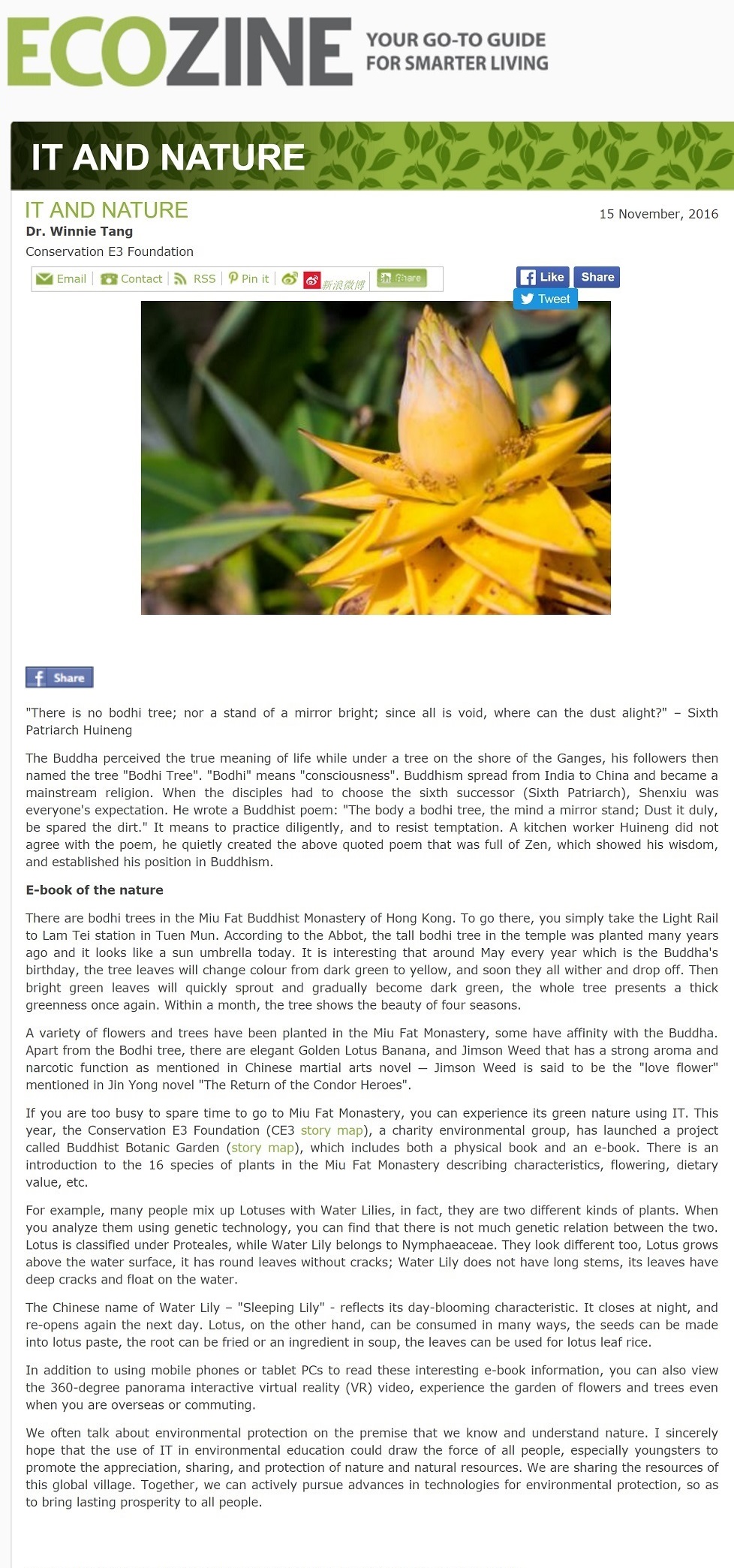網上版請按此

IT AND NATURE
"There is no bodhi tree; nor a stand of a mirror bright; since all is void, where can the dust alight?" – Sixth Patriarch Huineng
The Buddha perceived the true meaning of life while under a tree on the shore of the Ganges, his followers then named the tree "Bodhi Tree". "Bodhi" means "consciousness". Buddhism spread from India to China and became a mainstream religion. When the disciples had to choose the sixth successor (Sixth Patriarch), Shenxiu was everyone's expectation. He wrote a Buddhist poem: "The body a bodhi tree, the mind a mirror stand; Dust it duly, be spared the dirt." It means to practice diligently, and to resist temptation. A kitchen worker Huineng did not agree with the poem, he quietly created the above quoted poem that was full of Zen, which showed his wisdom, and established his position in Buddhism.
E-book of the nature
There are bodhi trees in the Miu Fat Buddhist Monastery of Hong Kong. To go there, you simply take the Light Rail to Lam Tei station in Tuen Mun. According to the Abbot, the tall bodhi tree in the temple was planted many years ago and it looks like a sun umbrella today. It is interesting that around May every year which is the Buddha's birthday, the tree leaves will change colour from dark green to yellow, and soon they all wither and drop off. Then bright green leaves will quickly sprout and gradually become dark green, the whole tree presents a thick greenness once again. Within a month, the tree shows the beauty of four seasons.
A variety of flowers and trees have been planted in the Miu Fat Monastery, some have affinity with the Buddha. Apart from the Bodhi tree, there are elegant Golden Lotus Banana, and Jimson Weed that has a strong aroma and narcotic function as mentioned in Chinese martial arts novel ─ Jimson Weed is said to be the "love flower" mentioned in Jin Yong novel "The Return of the Condor Heroes".
If you are too busy to spare time to go to Miu Fat Monastery, you can experience its green nature using IT. This year, the Conservation E3 Foundation (CE3 story map), a charity environmental group, has launched a project called Buddhist Botanic Garden (story map), which includes both a physical book and an e-book. There is an introduction to the 16 species of plants in the Miu Fat Monastery describing characteristics, flowering, dietary value, etc.
For example, many people mix up Lotuses with Water Lilies, in fact, they are two different kinds of plants. When you analyze them using genetic technology, you can find that there is not much genetic relation between the two. Lotus is classified under Proteales, while Water Lily belongs to Nymphaeaceae. They look different too, Lotus grows above the water surface, it has round leaves without cracks; Water Lily does not have long stems, its leaves have deep cracks and float on the water.
The Chinese name of Water Lily – "Sleeping Lily" - reflects its day-blooming characteristic. It closes at night, and re-opens again the next day. Lotus, on the other hand, can be consumed in many ways, the seeds can be made into lotus paste, the root can be fried or an ingredient in soup, the leaves can be used for lotus leaf rice.
In addition to using mobile phones or tablet PCs to read these interesting e-book information, you can also view the 360-degree panorama interactive virtual reality (VR) video, experience the garden of flowers and trees even when you are overseas or commuting.
We often talk about environmental protection on the premise that we know and understand nature. I sincerely hope that the use of IT in environmental education could draw the force of all people, especially youngsters to promote the appreciation, sharing, and protection of nature and natural resources. We are sharing the resources of this global village. Together, we can actively pursue advances in technologies for environmental protection, so as to bring lasting prosperity to all people.
By: Dr. Winnie Tang, Founder and Chairman of Conservation E3 Foundation (CE3)